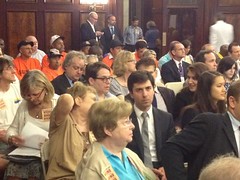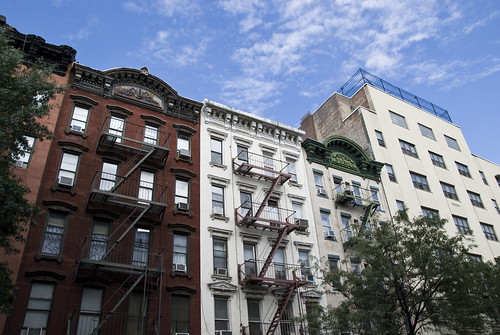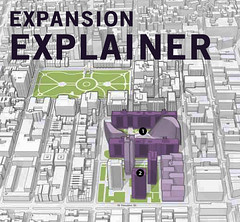 N.Y.U. Red lines indicate the reduction of the boomerang buildings on the northern block.
N.Y.U. Red lines indicate the reduction of the boomerang buildings on the northern block.A City Council committee voted in favor of New York University’s expansion plan on Tuesday following last minute negotiations that yielded several significant reductions of the project.
The land use committee’s 19-1 vote sends the plan, dubbed N.Y.U. 2031, to the full City Council, which will vote on the plans later this month. Councilwoman Margaret Chin, a member of the committee who represents Greenwich Village, took the lead in negotiations with the university and strongly urged other council members to support the modified plan.
“I wholeheartedly believe that this proposal will allow N.Y.U.’s growth in the Village to occur at a sustainable pace, and that it will not overwhelm the wider Village community,” Ms. Chin said. “Over the past few months, I have heard a litany of N.Y.U.’s broken promises from Village residents. It is time to start a new chapter.” Read more…
 Sarah Darville Matthew Broderick, in glasses.
Sarah Darville Matthew Broderick, in glasses.The City Council hearing on New York University’s controversial expansion plan got a star cameo today, as Greenwich Village native Matthew Broderick argued that N.Y.U. 2031 would further strip the neighborhood of of its character. He was one of about 250 people who spoke out during the packed nine-hour meeting, with about 60 percent opposing the plan and 40 percent voicing their support.
Six hours before the actor testified, N.Y.U.’s president, John Sexton, started the hearing (which The Local liveblogged earlier today) by vigorously defending the project and the university’s need to expand. “This is not a development project. This is an academic project,” he said, explaining that more space was needed to recruit top-quality faculty and students.
Asked why N.Y.U. couldn’t look to other parts of the city, Mr. Sexton told council member Leroy Comrie that further dissipation of N.Y.U.’s activities across the city would amplify the perception that it doesn’t have a traditional campus “or a big football stadium where we gather,” turning off potential students.
“This is the most enlightened way to do this,” said Mr. Sexton, who also used his presentation to announce that a “huge initiative” for financial aid would be coming soon. Read more…
As Village residents await Borough President Scott Stringer’s recommendation early next month regarding N.Y.U.’s expansion plans, The Local is taking a look at the impacts of the project. Today, we’re examining the concerns surrounding the replacement of a dog run under the proposed development. Yesterday, we looked at the impact the proposal would have on three playgrounds in Greenwich Village. Check back for our coverage of concerns surrounding loss of light and the LaGuardia Community Garden.
Q.
So what does the future hold for the dog run at the corner of Houston and Mercer Streets should N.Y.U.’s expansion be approved?
A.
 N.Y.U. The proposed dog run.
N.Y.U. The proposed dog run.The dogs and their roughly 300 owners at the Mercer-Houston Dog Run will have to be relocated to make way for the Zipper building, which will be 26 stories at its highest point. The building would extend almost the entire length of the south block along Mercer Street between Houston and Bleecker Streets. In addition to housing, academic, retail space and a hotel, the new structure would also hold the replacement for the Morton Williams Supermarket at the northwest corner of the south block. The university says the replacement grocery store would be fully operational before Morton Williams is demolished in 2018. Read more…
 Rachel Wise
Rachel WiseGood morning, East Village.
There’s a piece in Capital today about Alicia Hurley, the NYU vice president charged with explaining the intricacies of the university’s hotly debated expansion plan to members of the community.
Seeing this piece prompts us to remind you all about our intention to cover news coming out of the university as fairly and as comprehensively as we can.
To that end, Kim Davis, our community editor whose work you might have already read on the site, will take a lead role in shaping our coverage of the university.
None of us is naïve about the nature of the debate about the university’s role in the community. This is an issue about which we at The Local have given a great deal of thought and planning and we certainly invite your comments and questions about how we intend to manage our relationship with the university.
It should also be noted that when The Local was being developed, one of the first steps that we took was contacting the university administration to inform them that we planned to vigorously exercise our independence as journalists. The university expressed no objection and has made no effort to influence the blog’s editorial content.
This blog is not the voice of the university – it is, as we’ve said from the outset, an experiment in journalistic collaboration, born of the efforts of faculty and students of the Arthur L. Carter Journalism Institute who then reached out to The New York Times as a media partner.
We’ll talk more about this in the days and weeks to come but, again, we’d like to hear from you about this.








